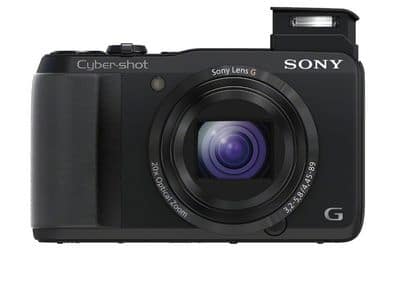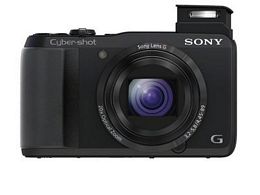
The Sony Cyber-shot DSC-HX20V is the mid-range model in Sony’s trio of GPS armed travel zoom cameras, which consist of the HX10V, the HX20V, and the HX30V. All of them use the same 18.2 Megapixel sensor but, the HX10V has only a 16X zoom lens while both the HX20V and the HX30V have the larger 20X lens. The HX30V is the flagship of the trio and most popular seller thus far because of its Wi-Fi support.
The HX20V not only has the 20X lens but also has both the automatic and the various manual controls, multi shot options and HDR, a panorama feature, and full HD/1080 video recording capabilities. All of this comes in a pocketsize camera that is a great travel option that won’t take up much space but offers many qualities.
The Technical Specifications for the Cyber-shot DSC-HX20V
- 105 MB of built- in memory
- It supports both the SD/SDHC/SDXC and Memory Stick Pro Duo cards
- The camera uses the same NP-BG1 lithium battery as the other Sony cameras
- It supports the NP-FG1 Infolithium battery
- The maximum resolution is 4896 X 3672
- Image Ratio is 4:3, 16.9
- 18.2 megapixels
- 18.9 sensor photo detectors
- 1 /2.3 sensor size with a BSI-CMOS sensor
- PIONZ processor
- ISO from 100 to 12800 and auto
- 7 white balance presets
- Optical image stabilization
- The focal length ranges from 25-500 mm
- Battery life (CIPA) 320
- 3 inch viewfinder
- 11 exposure modes and 15 scene modes
- Built in GPS
- Movie mode with Full HD video 1920 X 1080
Contents
The Body and Design
The DSC-HX20V compact ultra zoom camera is both a mixture of plastic and metal that is durable. The dimensions are 4.3 X 2.5 x 1.4 inches 15.1 cubic inches, one of the largest in its class compared to the smallest Samsung WB850F, which is 10.3 cubic inches and the Panasonic Lumix DMC-ZS20 at 12.3 cubic inches. Most of the buttons and knobs are well placed with a few exceptions. These problematic buttons are located on the top back of the camera. This makes it difficult to use when the flash is popped up. The USB port is situated on the bottom of the camera, which seems like an unusual placement for something that is used so often. With everything else put together so nicely, these glitches are minimal. This small camera has a fine 20X zoom lens. It has optical image stabilization that reduces blurry photos in low light or when using a telephoto lens. The Sony “G” lens uses an all-new F3.2-5.8 20X optical lens with focal range of 4.45- 89.0 mm, equivalent to a 25-500 mm.
It is what is behind the lens that makes for great image quality. The 18.2 Megapixel back-illuminated CMOS sensor that Sony calls “EXmor R” is the highest resolution sensor to be found in a compact camera.
The Flash
In the upper right corner of the camera is the pop-up, built in flash, released electronically with a working range from 0.4- 7.1m at wide-angle and 1.5- 3.9 m at telephoto. This is above average for a pop –up lens. There is no external flash option.
The LCD Display
The 3-inch LCD is a high-resolution display that with its 921,000 pixels produces incredibly sharp pictures. The lighting in outdoor shooting is average and there is a bit of a problem in low light settings. When the ISO is increased, the screen brightness will be better but with this there are noisier photos.
More about the Buttons and Other Body Elements
On the top of the back is a great spot for the camera’s dedicated movie recording button. It is located directly next to the thumb rest and is easy to reach. It allows you to record videos in any of the video modes. Under the thumb rest is located the four way controller for menu navigation, adjusting exposure, and photo flipping. The display also directs the buttons for Display, Photo Creativity, and the other drive and flash modes. On top of the camera is the shutter release button and the zoom controller which moves the lens from telephoto to wide-angle in 2.2 seconds.
The metal tripod mount is to the right of the battery/memory card compartment with two poorly placed micro-USB ports that are not visible. So when the tripod is being used, this compartment will be difficult to use.
The Exposure Mode Dial Options
There are endless options that make picture-taking an easy process. First there is the intelligent auto mode, which will choose the scene selection and allow you to use the Photo Creativity controls. There is also the Superior Auto mode that allows for multi-exposure shots like HDR, twilight and anti-motion blur. There is full manual mode in which you can choose your shutter speed and aperture at the same time. There is even a memory recall mode to access your favorite settings quickly.
There is a panorama mode and a huge selection of scene modes from HDR, soft skin, landscape, night portrait, pet, beach, snow, fireworks, 2D, 3D, and advanced sports shooting. There is a digital focus that keeps the object in the foreground in-focus and blurs the background at the same time.
The GPS
The HX20 V’s GPS system is a no frills type structure. There is no landmark or database like the Fuji or the Panasonic. With this you get the location and the direction and that’s it. You can reduce the delay time by loading “assist data” into the camera. This is included in the software that comes with the camera. There is a compass included, too.
Nikon Coolpix P510 vs Sony Cyber-shot DSC HX20V
| Nikon Coolpix P510 | Sony Cyber-shot DSC HX20V | |
|---|---|---|
| Max Resolution | 4608 x 3456 | 4896 x 3672 |
| Image Ratio | 1:1, 4:3, 3:2, 16:9 | 4:3, 16:9 |
| Effective Pixels | 16.0 | 18.2 |
| Sensor Type | BSI-CMOS | BSI-CMOS |
| Sensor Size | 1/2.3" (6.17 x 4.55 mm) | 1/2.3" (6.17 x 4.55 mm) |
| Optical Zoom | 41.7 | 30 |
| LCD Size | 3 | 3 |
| LCD Dots | 921,000 | 921,600 |
| Touch Screen | No | No |
| Live View | Yes | Yes |
| Viewfinder | Electronic | Electronic |
| Max Aperture | F3.0 – F5.9 | F2.8 – F5.6 |
| Storage | SD/SDHC/SDXC | SD/SDHC/SDXC, Memory Stick Duo/Pro Duo/Pro-HG Duo |
The Drive Modes
There are four types; continuous shooting, bracket shooting which allows for three shots in a row, the self portrait timer, the self-timer continuous shooting and the self-timer bracket. The self-timer bracket is a great option because it starts bracketing after a 10 second countdown.
The Movie Mode
This is one of the few cameras that can record full HD video at 60p. The camera allows you to use the optical zoom during recording and the lens moves smoothly and quietly to keep the noise from being picked up by the stereo microphones. It is totally point and shoot and most of the cameras picture effects can also be used for movies as well.
Conclusion
The picture quality is great. This travel camera is durable and has a high-resolution zoom lens and EXmor R CMOS sensor that provide us with everything from extreme- close ups to panoramic scenes. The automatic modes produce vibrant, consistent results. With all of the bells and whistles, this little camera is a fine choice in the $360 to $400 dollar range.
